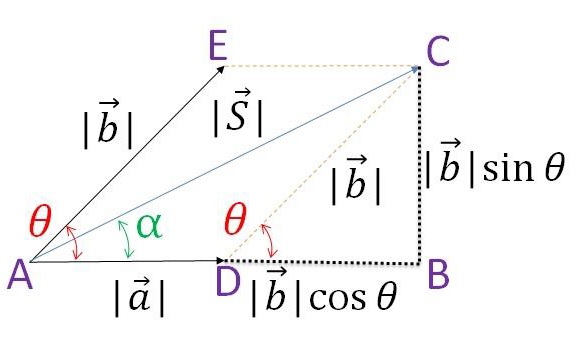Vectors - Derivation of Addition Formula
Description:
Formula to find the magnitude and direction of the resultant vector
Note
- Parallelogram law of addition is used for this derivation.
- Triangle Law method will yield the same result.
Derivation

a→ and b→ are considered as the original vectors. Angle between them is ‘θ’
S→ is the resultant vector.
Aim is to find the magnitude (length) of the resultant vector (|S|→) and the angle ‘α’ (angle between the resultant and a→).
Construction −
Extend the line AD
Drop a perpendicular from point C on to the extended line. Perpendicular meets the line at point B.
▱ AEDC is a parallelogram, hence AE = DC. Hence, DC = |b|→ or DC = b.
▱ AEDC is a parallelogram, hence AE∥DC. Also, AD is a transversal to it. This implies ∠EAD = ∠CDB = θ.
Now, in △BCD,
sin θ = BCDC, hence, BC = |b|→ sin θ or b sin θ
cos θ = BDCD, hence, BD = |b|→ cos θ or b cos θ
Finally, in △ABC,
Using Pythagoras’ theorem, |S|→2 = (|a|→ + |b|→ cos θ)2 + (|b|→ sin θ)2
This implies, |S|→ = √(|a|→ + |b|→ cos θ)2 + (|b|→ sin θ)2
This implies, |S|→ = √|a|→2 + |b|→2 + 2(|a|→)(|b|→)cos θ .. PROVED
Also, tan θ =
|b|→sin θ|a|→ + |b|→cos θ... PROVED
Note
1. The magnitude of resultant depends on two factors −
The magnitudes of original vectors
Angle between the original vectors
2. The sign convention for the angle is −
Anticlockwise direction is positive (+)
Clockwise direction is negative (-)

